Integrating Urban Planning and Hydraulic Engineering: Nature-Based Solutions for Flood Mitigation in Tainan City
Abstract
1. Introduction
2. Materials and Methods
2.1. Study Area
2.2. Methodology
- Efficient runoff computation with reduced computational time.
- Capability to output flow and hourly water level hydrographs for specific regions.
- Applicability in real-time flood forecasting and early warning systems.
- Enhanced adaptability to actual land use patterns, improving the model’s reliability.
2.2.1. PHD Model Construction
- (1)
- Continuity Equation of Flow
- (2)
- Numerical Method
2.2.2. Principles for Constructing the Non-Structured Computational Grid
- (1)
- Grid cells should share the same hydrometeorological conditions.
- (2)
- Roads, levees, or natural terrain features should be used as grid boundaries.
- (3)
- The area difference between adjacent grid cells should be minimized.
2.2.3. Validation of PHD Model
2.3. Site Selection for Flood Mitigation Measures and Estimation of Flood Detention Capacity
2.3.1. Identification of Suitable Land for Flood Mitigation Measures
2.3.2. Estimation Approach for Flood Detention Capacity
2.4. Rainfall Scenarios
3. Flood Simulation Results and Findings
3.1. Simulation Results and Impact of Climate Change on Inundation Depth and Extent
3.2. Flood Mitigation Implementation Results in Tainan City
- (1)
- Impacts of Inundation Depths Exceeding 0.3 m
- (2)
- Severe Flooding with Inundation Depths Exceeding 2.0 m
3.3. Flood Mitigation Implementation Results in Tainan Science Park Special District Plan Area
- (1)
- Impacts of Inundation Depths Exceeding 0.3 m
- (2)
- Severe Flooding with Inundation Depths Exceeding 2.0 m
4. Discussion
4.1. Importance of Integrated Urban Planning and Hydraulic Engineering in Flood Risk Management
4.2. Study Scope and Rainfall Scenario Selection
4.3. NbS-Based Flood Mitigation Strategies and Land Use Considerations
4.4. Citywide Flood Mitigation Effectiveness
4.5. Flood Mitigation Effectiveness in Tainan Science Park Special District Plan Area
4.6. Implications for Future Flood Mitigation Strategies
5. Conclusions
Author Contributions
Funding
Data Availability Statement
Acknowledgments
Conflicts of Interest
References
- Thanvisitthpon, N.; Nakburee, A.; Saguansap, P.; Mruksirisuk, P. Climate change-induced urban flooding trend analysis and land use change: A case study of flood-prone Pathumthani Province, Thailand. Environ. Dev. Sustain. 2024, 27, 4731–14754. [Google Scholar] [CrossRef]
- Blöschl, G.; Hall, J.; Viglione, A.; Perdigão, R.A.; Parajka, J.; Merz, B.; Lun, D.; Arheimer, B.; Aronica, G.T.; Bilibashi, A.; et al. Changing climate both increases and decreases European river floods. Nature 2019, 573, 108–111. [Google Scholar] [CrossRef]
- Tellman, B.; Sullivan, J.A.; Kuhn, C.; Kettner, A.J.; Doyle, C.S.; Brakenridge, G.R.; Erickson, T.A.; Slayback, D.A. Satellite imaging reveals increased proportion of population exposed to floods. Nature 2021, 596, 80–86. [Google Scholar] [CrossRef]
- Sim, S.B.; Kim, H.J. The impact of storm sewer network simplification and rainfall runoff methods on urban flood analysis. Water 2024, 16, 3307. [Google Scholar] [CrossRef]
- Arnold, C.L., Jr.; Gibbons, C.J. Impervious surface coverage: The emergence of a key environmental indicator. J. Am. Plan. Assoc. 1996, 62, 243–258. [Google Scholar] [CrossRef]
- Pauleit, S.; Ennos, R.; Golding, Y. Modeling the environmental impacts of urban land use and land cover change—A study in Merseyside, UK. Landsc. Urban Plan. 2005, 71, 295–310. [Google Scholar] [CrossRef]
- Sajikumar, N.; Remya, R.S. Impact of land cover and land use change on runoff characteristics. J. Environ. Manag. 2015, 161, 460–468. [Google Scholar] [CrossRef]
- IPCC. Climate Change 2023: Synthesis Report, Contribution of Working Groups I, II and III to the Sixth Assessment Report of the Intergovernmental Panel on Climate Change; IPCC: Geneva, Switzerland, 2023; pp. 35–115. [Google Scholar] [CrossRef]
- Lo, W.; Huang, C.T.; Wu, M.H.; Doong, D.J.; Tseng, L.H.; Chen, C.H.; Chen, Y.-J. Evaluation of flood mitigation effectiveness of nature-based solutions potential cases with an assessment model for flood mitigation. Water 2021, 13, 3451. [Google Scholar] [CrossRef]
- Ku, C.A. Simulating future land use exposure to extreme floods in metropolitan areas based on an integrated framework. Urban Clim. 2021, 35, 100738. [Google Scholar] [CrossRef]
- Kling, H.; Fuchs, M.; Paulin, M. Runoff conditions in the upper Danube basin under an ensemble of climate change scenarios. J. Hydrol. 2012, 424, 264–277. [Google Scholar] [CrossRef]
- Xu, Z.; Zhao, G. Impact of urbanization on rainfall-runoff processes: Case study in the Liangshui River Basin in Beijing, China. Proc. Int. Assoc. Hydrol. Sci. 2016, 373, 7–12. [Google Scholar] [CrossRef]
- Echendu, A.; Georgeou, N. ‘Not going to plan’: Urban planning, flooding, and sustainability in Port Harcourt City, Nigeria. Urban Forum 2021, 32, 311–332. [Google Scholar] [CrossRef]
- Park, K.; Oh, H.; Won, J.H. Analysis of disaster resilience of urban planning facilities on urban flooding vulnerability. Environ. Eng. Res. 2021, 26, 190529. [Google Scholar] [CrossRef]
- Martínez-Graña, A.M.; Gago, C. Environmental analysis of flood risk in urban planning: A case study in Las Quemadillas, Córdoba, Spain. Environ. Eng. Manag. J. 2018, 17, 2527–2536. [Google Scholar] [CrossRef]
- Neves, J.L. Urban planning for flood resilience under technical and financial constraints: The role of planners and competence development in building a flood-resilient city in Matola, Mozambique. City Environ. Interact. 2024, 22, 100147. [Google Scholar] [CrossRef]
- Echendu, A.J. Relationship between urban planning and flooding in Port Harcourt city, Nigeria; insights from planning professionals. J. Flood Risk Manag. 2021, 14, e12693. [Google Scholar] [CrossRef]
- Bertilsson, L.; Wiklund, K.; Tebaldi, I.; Rezende, O.M.; Veról, A.P.; Miguez, M.G. Urban flood resilience—A multi-criteria index to integrate flood resilience into urban planning. J. Hydrol. 2019, 573, 970–982. [Google Scholar] [CrossRef]
- Chiu, Y.Y.; Raina, N.; Chen, H.E. Evolution of flood defense strategies: Toward nature-based solutions. Environments 2021, 9, 2. [Google Scholar] [CrossRef]
- Reaney, S.M. Spatial targeting of nature-based solutions for flood risk management within river catchments. J. Flood Risk Manag. 2022, 15, e12803. [Google Scholar] [CrossRef]
- Long, P.; Taka, M.; Lashford, C.; Charlesworth, S. Nature-based solutions for sustainable flood management in East Africa. J. Flood Risk Manag. 2024, 17, e12954. [Google Scholar] [CrossRef]
- Rosmadi, H.S.B.; Ahmed, M.F.; Mokhtar, M.B.; Halder, B.; Scholz, M. Nature-Based Solutions (NbS) for Flood Management in Malaysia. Water 2024, 16, 3606. [Google Scholar] [CrossRef]
- Zannat, M.E.; Dedekorkut-Howes, A.; Morgan, E.A. A review of nature-based infrastructures and their effectiveness for urban flood risk mitigation. Wiley Interdiscip. Rev. Clim. Change 2024, 15, e889. [Google Scholar] [CrossRef]
- Thaler, T.; Slavíková, L.; Hartmann, T. Nature-based solutions in flood risk management. Wiley Interdiscip. Rev. Water 2025, 12, e7006. [Google Scholar] [CrossRef]
- European Commission. EU Strategy on Adaptation to Climate Change; European Commission: Brussels, Belgium, 2021. [Google Scholar]
- Rohde, S.; Hostmann, M.; Peter, A.; Ewald, K.C. Room for rivers: An integrative search strategy for floodplain restoration. Landsc. Urban Plan. 2006, 78, 50–70. [Google Scholar] [CrossRef]
- Rauter, M.; Kaufmann, M.; Thaler, T.; Fuchs, S. Flood risk management in Austria: Analysing the shift in responsibility-sharing between public and private actors from a public stakeholder’s perspective. Land Use Policy 2020, 99, 105017. [Google Scholar] [CrossRef]
- Burek, P.; Mubareka, S.; Rojas, R.; De Roo, A.; Bianchi, A.; Baranzelli, C.; Lavalle, C.; Vandecasteele, I. Evaluation of the effectiveness of natural water retention measures. In JRC Report; JRC: Seville, Spain, 2012. [Google Scholar] [CrossRef]
- Newcomer, M.E.; Gurdak, J.J.; Sklar, L.S.; Nanus, L. Urban recharge beneath low impact development and effects of climate variability and change. Water Resour. Res. 2014, 50, 1716–1734. [Google Scholar] [CrossRef]
- Damodaram, C.; Giacomoni, M.H.; Prakash, C.; Holmes, H.; Ryan, A.; Saour, W.; Zechman, E.M. Simulation of combined best management practices and low impact development for sustainable stormwater management. J. Am. Water Resour. Assoc. 2010, 46, 907–918. [Google Scholar] [CrossRef]
- Berndtsson, J.C. Green roof performance towards management of runoff water quantity and quality: A review. Ecol. Eng. 2010, 36, 351–360. [Google Scholar] [CrossRef]
- Water Resources Agency. The Expected Benefits of Local Flood Detention in Youcai Village; Water Resources Agency: Taipei, Taiwan, 2021.
- Water Resources Planning Branch, Water Resources Agency, Ministry of Economic Affairs (WRA, MOEA). Analysis and Application of Hydrological Scenarios; Water Resources Planning Branch, WRA, MOEA: Taipei, Taiwan, 2023.
- Collentine, D.; Futter, M.N. Realising the potential of natural water retention measures in catchment flood management: Trade-offs and matching interests. J. Flood Risk Manag. 2018, 11, 76–84. [Google Scholar] [CrossRef]
- Tóth, T. Application of Natural Water Retention Measures in Flood Management. Műszaki Katonai Közlöny 2019, 29, 139–152. [Google Scholar] [CrossRef]
- Huang, Y.-S. Hydrological and Hydraulic Characteristics and Operation of Local Flood Detention Facilities. Master’s Thesis, Department of Civil Engineering, National Taiwan University, Taipei, Taiwan, 2023. [Google Scholar] [CrossRef]
- Water Resources Agency, Ministry of Economic Affairs. Runoff Allocation Technical Manual; Water Resources Agency, MOEA: Taipei, Taiwan, 2021.
- Khodadad, S.; Scholz, M.; Evans, B. Assessment of land-use suitability for nature-based solutions to manage flood risk in rapidly urbanizing cities. Water 2023, 15, 523. [Google Scholar] [CrossRef]
- Ministry of the Interior. Population Statistics of Tainan City. Department of Household Registration. 2025. Available online: https://data.tainan.gov.tw/ (accessed on 20 June 2025).
- U.S. Soil Conservation Service. National Engineering Handbook, Section 4: Hydrology; U.S. Department of Agriculture: Washington, DC, USA, 1972.
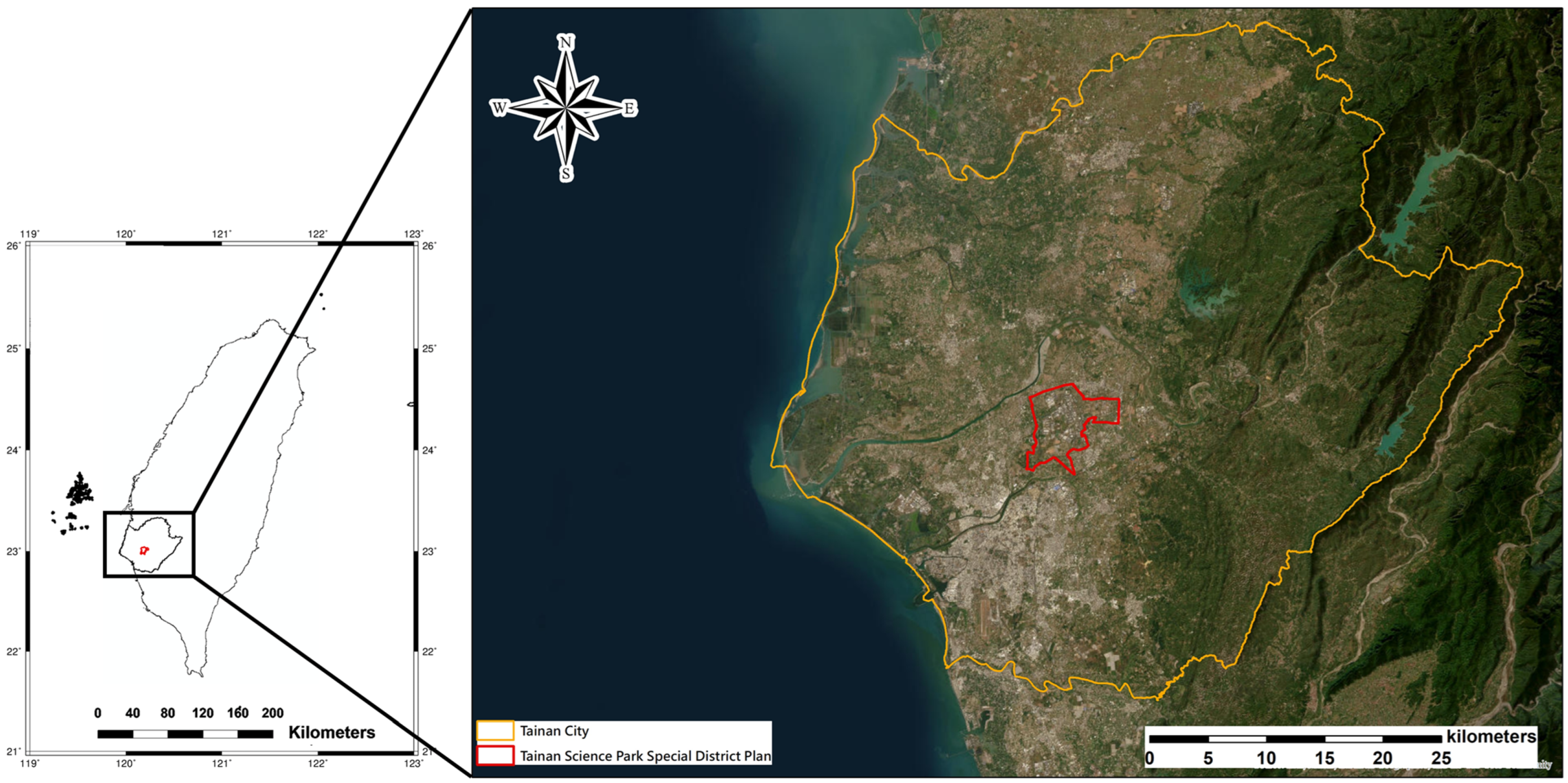
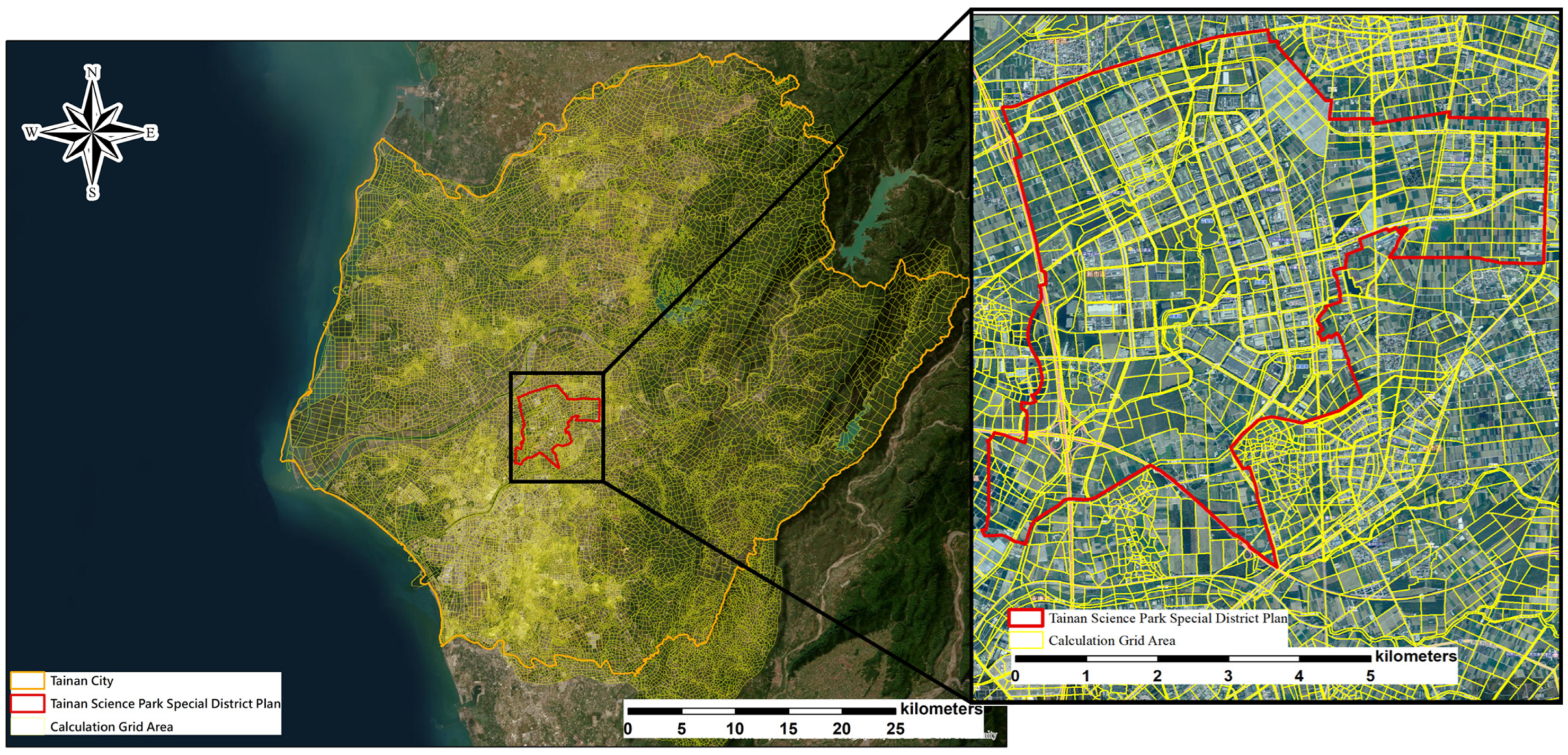
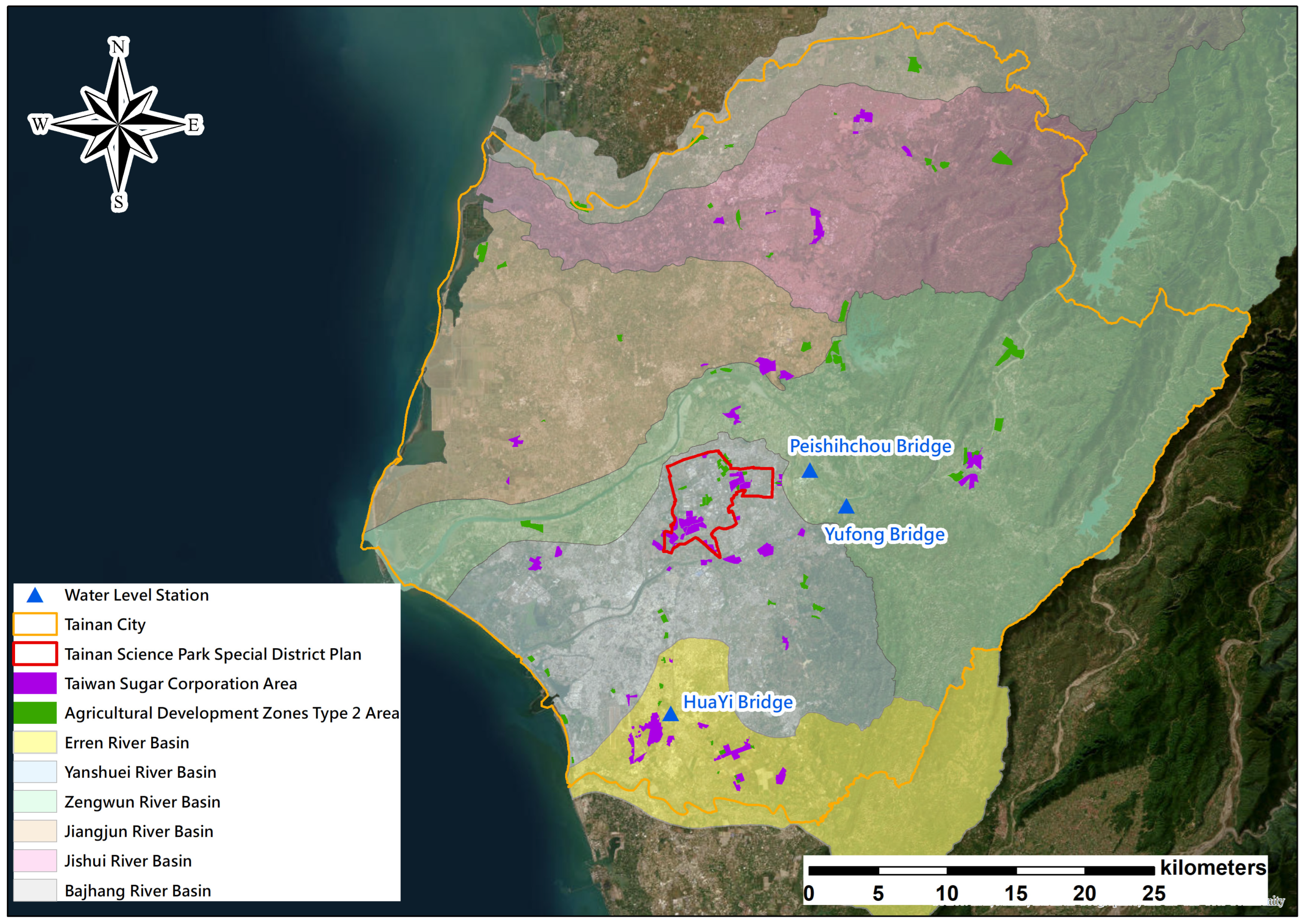
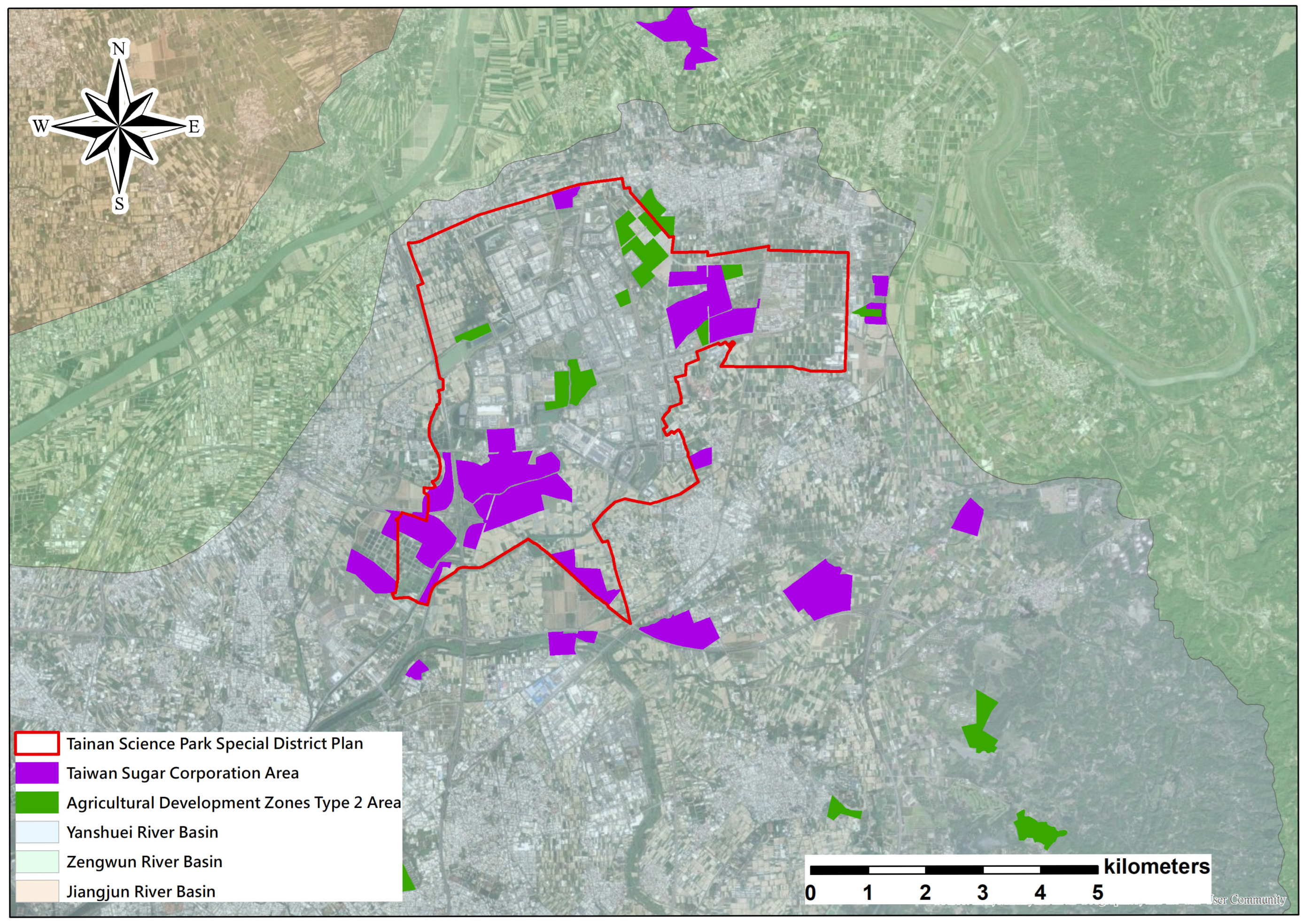
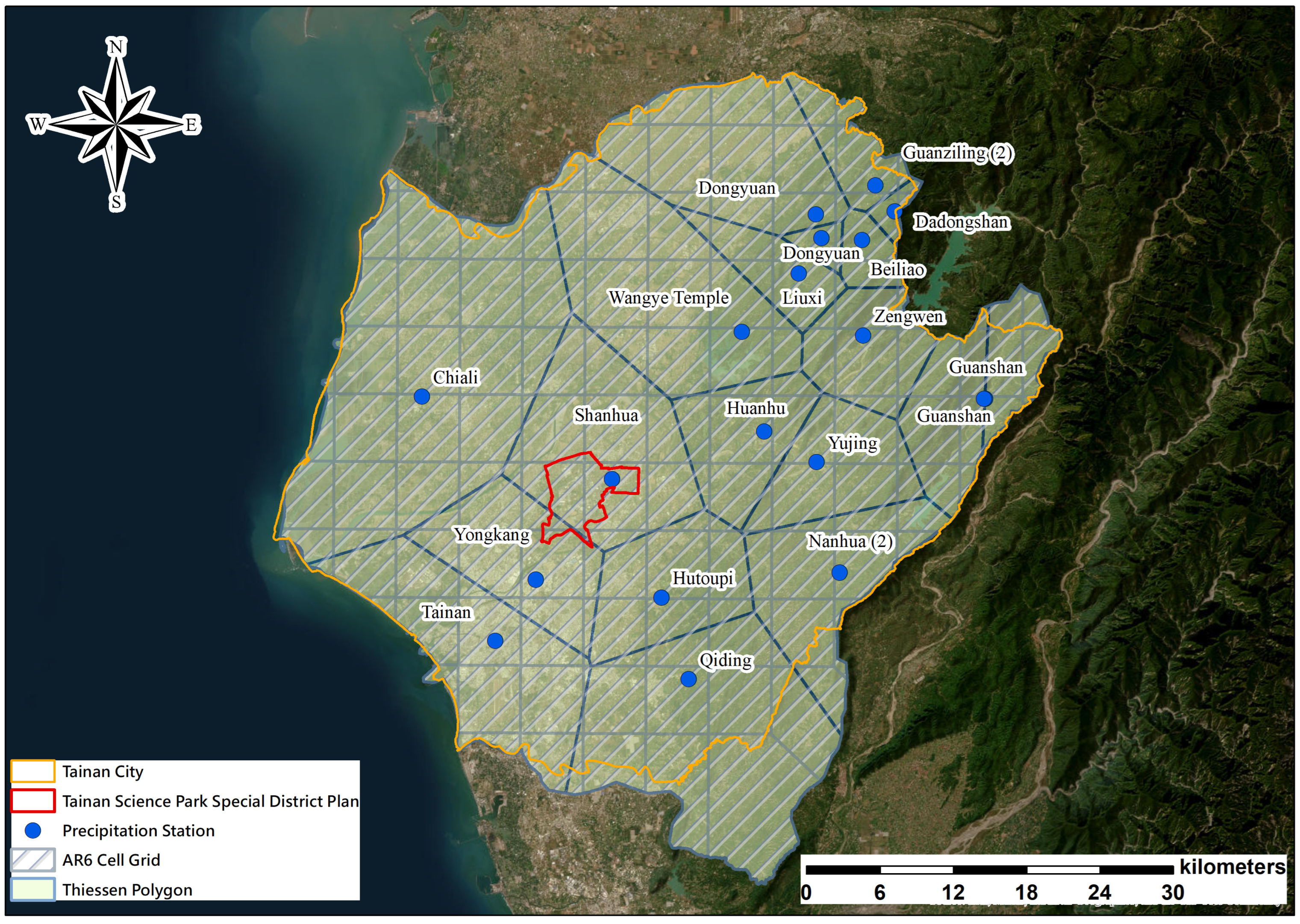
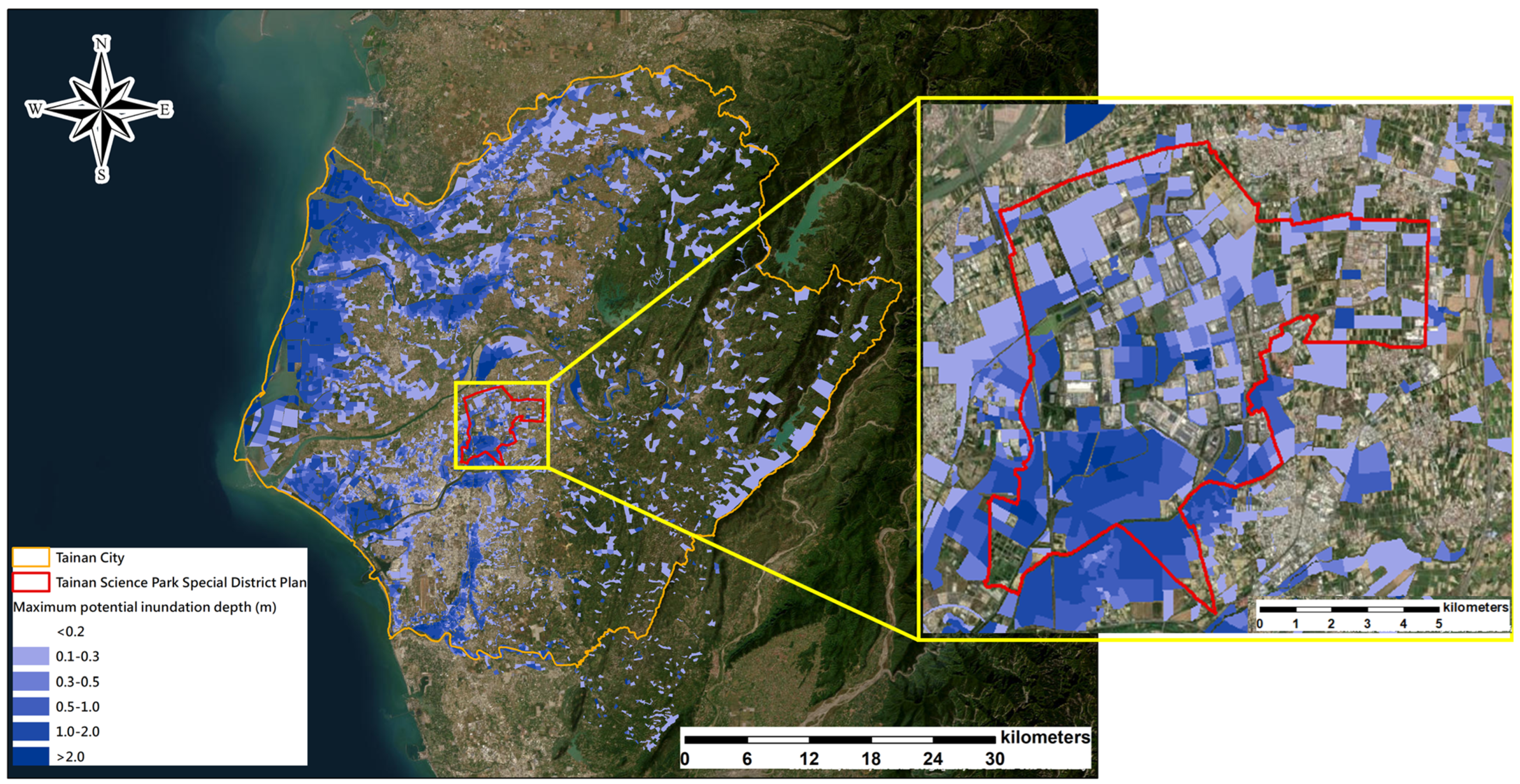
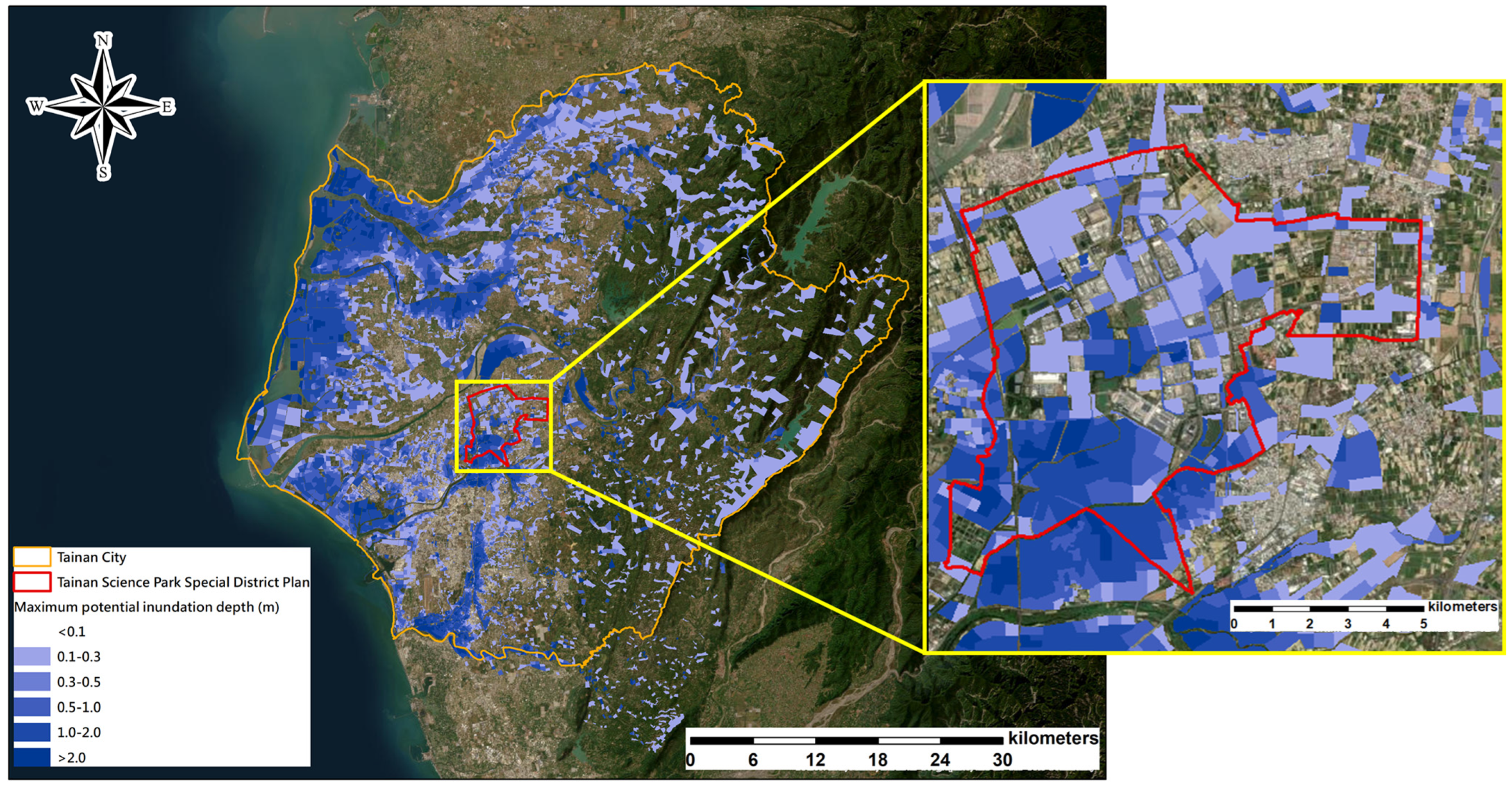
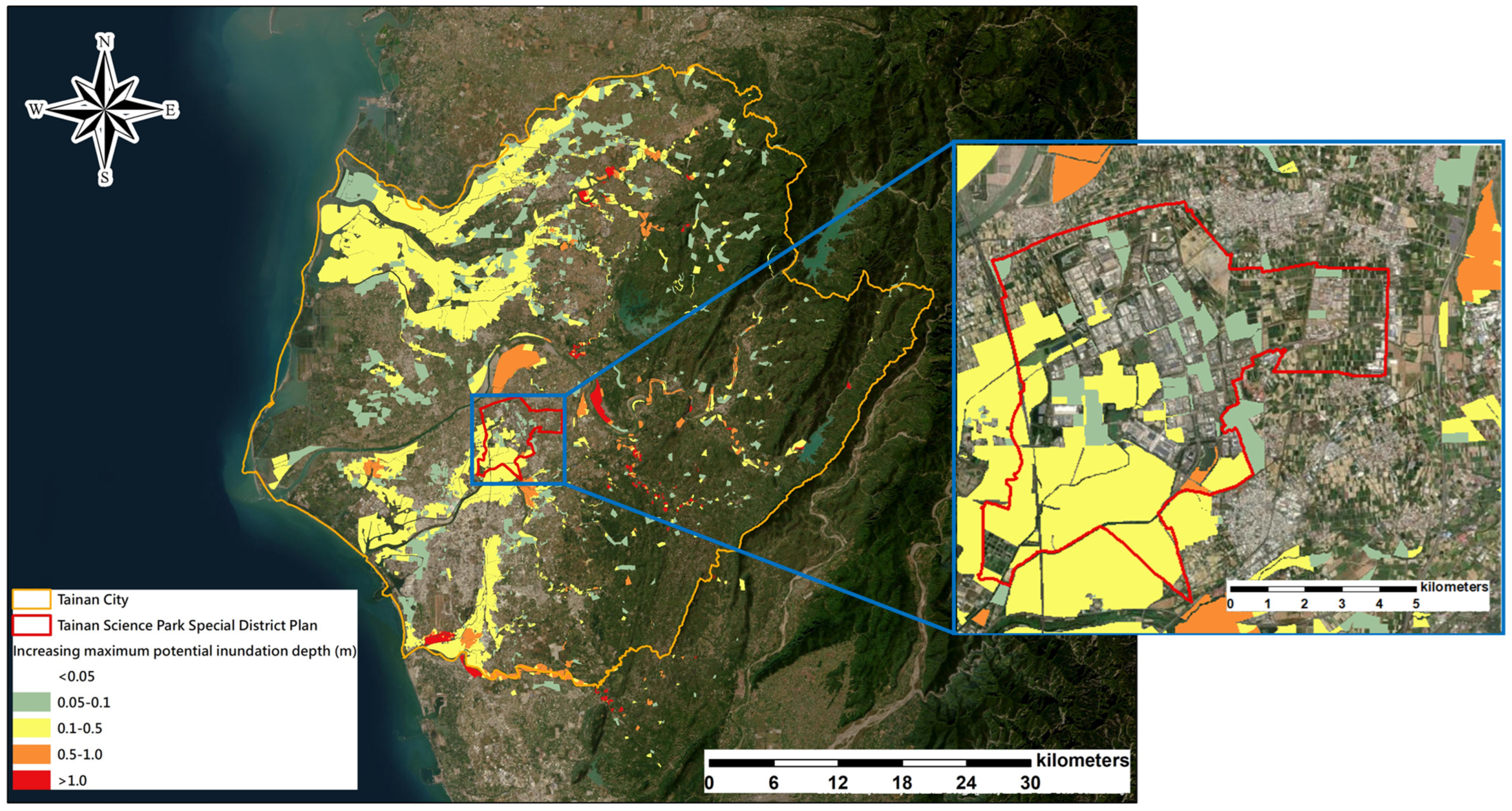
| Water Level Station | NSE | |
|---|---|---|
| 0823 Storm Event | 0605 Storm Event | |
| Peishihchou Bridge | 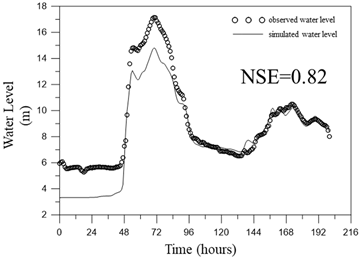 | 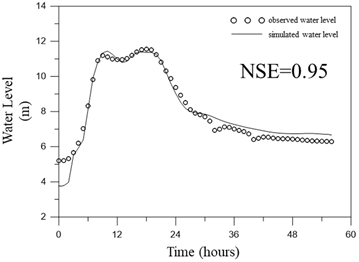 |
| Yufong Bridge | 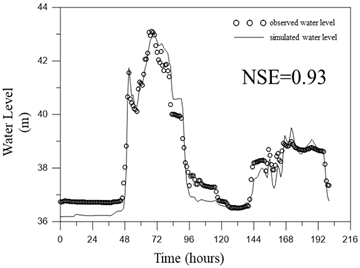 | 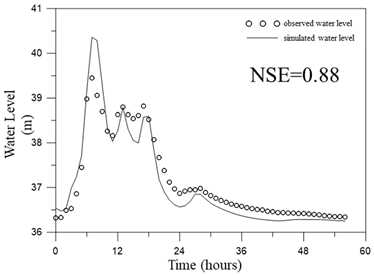 |
| HuaYi Bridge | 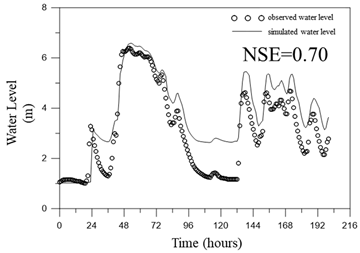 | 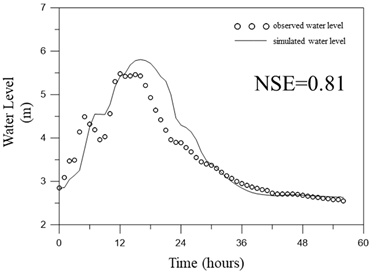 |
| River Basin | AGRI-DZII, Green Space, and Park | TSC Agri-Land | |||
|---|---|---|---|---|---|
| Name | Area (ha) | Area (ha) | Propotion (%) | Area (ha) | Propotion (%) |
| Erren River Basin | 35,000 | 22.27 | 0.06 | 274.75 | 0.79 |
| Bajhang River Basin | 47,474 | 20.85 | 0.04 | 0.00 | 0.00 |
| Jishui River Basin | 37,900 | 26.04 | 0.07 | 72.69 | 0.19 |
| Jiangjun River Basin | 15,840 | 11.28 | 0.07 | 60.98 | 0.38 |
| Zengwun River Basin | 117,664 | 83.34 | 0.07 | 25.04 | 0.02 |
| Yanshuei River Basin | 34,317 | 100.97 | 0.29 | 383.78 | 1.12 |
| Total | 288,195 | 264.74 | 0.61 | 817.24 | 2.50 |
| Land Use Districts | Urban Planning Act | Runoff Diversion Volume Assessment | |||
|---|---|---|---|---|---|
| Building Coverage Ratio (%) | Statutory Vacant Space Ratio (%) | Detention Area Ratio (%) | Permissible Detention Depth () | Land Detention Capacity Calculation () | |
| Park (<5 ha) | 15 | 85 | 65 | 0.2 | |
| Park (>5 ha) | 12 | 88 | 68 | 0.5 | |
| Green space | 0 | 100 | 25 | 0.3 | |
| Agricultural area | - | - | 100 | 0.5 | |
| Competent Authority | Rainfall Station | Increment (%) | Scenarios | |
|---|---|---|---|---|
| Current (Case0-P, mm) | Climate Change (Case0-C, mm) | |||
| Water Resources Agency | Guanziling (2) | 37.4 | 658.74 | 904.86 |
| Liuxi | 41.5 | 557.38 | 788.78 | |
| Dongyuan | 38.5 | 554.81 | 768.22 | |
| Beiliao | 30.7 | 679.32 | 887.77 | |
| Nanhua (2) | 44.0 | 562.89 | 810.75 | |
| Qiding | 29.0 | 435.59 | 562.10 | |
| Hutoupi | 30.4 | 447.43 | 583.27 | |
| Wangye Temple | 44.4 | 501.29 | 723.99 | |
| Central Weather Administration | Guanshan | 36.3 | 796.32 | 1085.17 |
| Tainan | 27.1 | 381.05 | 484.48 | |
| Yongkang | 22.4 | 382.01 | 467.42 | |
| Zengwen | 36.4 | 722.20 | 985.33 | |
| Shanhua | 22.9 | 403.16 | 495.51 | |
| Yujing | 40.6 | 551.71 | 775.48 | |
| Chiali | 35.3 | 365.38 | 494.37 | |
| Huanhu | 37.5 | 527.71 | 725.82 | |
| Dadongshan | 30.7 | 547.57 | 715.60 | |
| Guanshan | 36.3 | 574.40 | 782.74 | |
| Dongyuan | 41.5 | 541.65 | 766.52 | |
| Inundation Depth (m) | Inundation Area (ha) | Change in Area (ha) | Change (%) | |
|---|---|---|---|---|
| Case0-P | Case0-C | |||
| >0.1 | 78,703.6 | 95,314.1 | 16,610.5 | 21 |
| >0.3 | 47,705.9 | 59,046.9 | 11,341.0 | 24 |
| >0.5 | 35,190.7 | 44,514.8 | 9324.1 | 26 |
| >1.0 | 17,735.2 | 24,803.9 | 7068.6 | 40 |
| >2.0 | 3496.6 | 6148.4 | 2651.8 | 76 |
| Inundation Depth (m) | Inundation Area (ha) | Change in Area (ha) | Change (%) | |
|---|---|---|---|---|
| Case0-P | Case0-C | |||
| >0.1 | 2021.1 | 2320.4 | 299.3 | 13 |
| >0.3 | 1297.6 | 1463.2 | 165.6 | 11 |
| >0.5 | 960.1 | 1115.0 | 154.9 | 14 |
| >1.0 | 530.1 | 665.0 | 134.9 | 20 |
| >2.0 | 43.0 | 104.6 | 61.6 | 59 |
| Inundation Depth (m) | Case0-P | Case 1 | Case 2 | Case 3 | |||
|---|---|---|---|---|---|---|---|
| Inundation Area (ha) | Inundation Area (ha) | Change (%) | Inundation Area (ha) | Change (%) | Inundation Area(ha) | Change (%) | |
| >0.3 | 47,705.9 | 46,682.3 | 2.1 | 46,849.1 | 1.8 | 46,779.3 | 1.9 |
| >0.5 | 35,190.7 | 34,241.6 | 2.7 | 34,385.1 | 2.3 | 34,282.2 | 2.6 |
| >1.0 | 17,735.2 | 16,848.0 | 5.0 | 17,054.0 | 3.8 | 16,867.4 | 4.9 |
| >2.0 | 3496.6 | 3224.0 | 7.8 | 3253.0 | 7.0 | 3224.8 | 7.8 |
| Inundation Depth (m) | Case0-P | Case 1 | Case 2 | Case 3 | |||
|---|---|---|---|---|---|---|---|
| Inundation Area (ha) | Inundation Area (ha) | Change (%) | Inundation Area (ha) | Change (%) | Inundation Area(ha) | Change (%) | |
| >0.1 | 2021.1 | 1984.2 | 1.8 | 2006.8 | 0.7 | 2005.1 | 0.8 |
| >0.3 | 1297.6 | 1259.3 | 2.9 | 1306.5 | −0.7 | 1283.6 | 1.1 |
| >0.5 | 960.1 | 955.5 | 0.5 | 961.8 | −0.2 | 955.5 | 0.5 |
| >1.0 | 530.1 | 502.4 | 5.2 | 523.7 | 1.2 | 509.9 | 3.8 |
| >2.0 | 43.0 | 34.0 | 20.8 | 43.0 | 0.0 | 34.0 | 20.8 |
| Inundation Depth (m) | Case0-C | Case 1 | Case 2 | Case 3 | |||
|---|---|---|---|---|---|---|---|
| Inundation Area (ha) | Inundation Area (ha) | Change (%) | Inundation Area (ha) | Change (%) | Inundation Area(ha) | Change (%) | |
| >0.1 | 2320.4 | 2303.4 | 0.7 | 2320.4 | 0.0 | 2316.9 | 0.2 |
| >0.3 | 1463.2 | 1448.1 | 1.0 | 1463.2 | 0.0 | 1461.1 | 0.1 |
| >0.5 | 1115.0 | 1099.7 | 1.4 | 1115.0 | 0.0 | 1109.1 | 0.5 |
| >1.0 | 665.0 | 634.9 | 4.5 | 657.7 | 1.1 | 636.8 | 4.2 |
| >2.0 | 104.6 | 86.0 | 17.8 | 104.6 | 0.0 | 100.3 | 4.2 |
| Inundation Depth (m) | Case0-C | Case 1 | Case 2 | Case 3 | |||
|---|---|---|---|---|---|---|---|
| Inundation Area (ha) | Inundation Area (ha) | Change (%) | Inundation Area (ha) | Change (%) | Inundation Area(ha) | Change (%) | |
| >0.3 | 59,046.9 | 58,842.7 | 0.3 | 59,031.9 | 0.0 | 59,980.9 | 0.3 |
| >0.5 | 44,514.8 | 44,397.7 | 0.3 | 44,511.5 | 0.0 | 44,405.5 | 0.2 |
| >1.0 | 24,803.9 | 24,551.4 | 1.0 | 24,767.0 | 0.1 | 24,648.1 | 0.6 |
| >2.0 | 6148.4 | 24,551.4 | 1.6 | 6148.0 | 0.0 | 6059.6 | 1.4 |
Disclaimer/Publisher’s Note: The statements, opinions and data contained in all publications are solely those of the individual author(s) and contributor(s) and not of MDPI and/or the editor(s). MDPI and/or the editor(s) disclaim responsibility for any injury to people or property resulting from any ideas, methods, instructions or products referred to in the content. |
© 2025 by the authors. Licensee MDPI, Basel, Switzerland. This article is an open access article distributed under the terms and conditions of the Creative Commons Attribution (CC BY) license (https://creativecommons.org/licenses/by/4.0/).
Share and Cite
Lo, W.-C.; Wu, M.-H.; Wu, J.-Y.; Huang, Y.-S. Integrating Urban Planning and Hydraulic Engineering: Nature-Based Solutions for Flood Mitigation in Tainan City. Water 2025, 17, 2018. https://doi.org/10.3390/w17132018
Lo W-C, Wu M-H, Wu J-Y, Huang Y-S. Integrating Urban Planning and Hydraulic Engineering: Nature-Based Solutions for Flood Mitigation in Tainan City. Water. 2025; 17(13):2018. https://doi.org/10.3390/w17132018
Chicago/Turabian StyleLo, Wei-Cheng, Meng-Hsuan Wu, Jie-Ying Wu, and Yao-Sheng Huang. 2025. "Integrating Urban Planning and Hydraulic Engineering: Nature-Based Solutions for Flood Mitigation in Tainan City" Water 17, no. 13: 2018. https://doi.org/10.3390/w17132018
APA StyleLo, W.-C., Wu, M.-H., Wu, J.-Y., & Huang, Y.-S. (2025). Integrating Urban Planning and Hydraulic Engineering: Nature-Based Solutions for Flood Mitigation in Tainan City. Water, 17(13), 2018. https://doi.org/10.3390/w17132018







